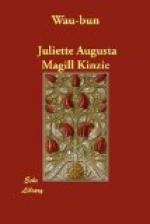Lee’s Place, since known by the name of Hardscrabble, was a farm intersected by the Chicago River, about four miles from its mouth. The farm-house stood on the western bank of the south branch of this river. On the north side of the main stream, but quite near its junction with Lake Michigan, stood (as has already been described) the dwelling-house and trading-establishment of Mr. Kinzie.
The fort was situated on the southern bank, directly opposite this mansion—the river, and a few rods of sloping green turf on either side, being all that intervened between them.
The fort was differently constructed from the one erected on the same site in 1816. It had two block-houses on the southern side, and on the northern a sally-port, or subterranean passage from the parade-ground to the river. This was designed either to facilitate escape in case of an emergency, or as a means of supplying the garrison with water during a siege.
The officers in the fort at this period were Captain Heald, the commanding officer, Lieutenant Helm, the son-in-law of Mr. Kinzie, and Ensign Ronan—the two last were very young men—and the surgeon, Dr. Van Voorhees.
The command numbered about seventy-five men; very few of whom were effective.
A constant and friendly intercourse had been maintained between these troops and the Indians. It is true that the principal men of the Pottowattamie nation, like those of most other tribes, went yearly to Fort Malden, in Canada, to receive a large amount of presents, with which the British Government had, for many years, been in the habit of purchasing their alliance; and it was well known that many of the Pottowattamies, as well as Winnebagoes, had been engaged with the Ottawas and Shawnees at the battle of Tippecanoe, the preceding autumn; yet, as the principal chiefs of all the bands in the neighborhood appeared to be on the most amicable terms with the Americans, no interruption of their harmony was at any time anticipated.
After the 15th of August, however, many circumstances were recollected that might have opened the eyes of the whites, had they not been lulled in a fatal security. One instance in particular may be mentioned.
In the spring preceding the destruction of the fort, two Indians of the Calumet band came to the fort on a visit to the commanding officer. As they passed through the quarters, they saw Mrs. Heald and Mrs. Helm playing at battledoor.
Turning to the interpreter, one of them, Nau-non-gee, remarked, “The white chiefs’ wives are amusing themselves very much; it will not be long before they are hoeing in our corn-fields!”
This was considered at the time an idle threat, or, at most, an ebullition of jealous feeling at the contrast between the situation of their own women and that of the “white chiefs’ wives.” Some months after, how bitterly was it remembered!
* * * * *




